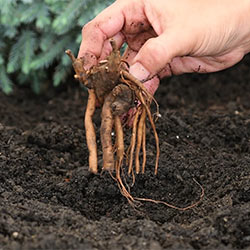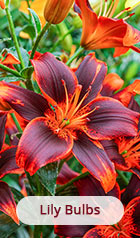Thank You!
We have received your request. You will be notified when this product is in stock.
X
Choose from single or double-flowered types, standards, trees, or shrubs. No matter which variety of Hibiscus plant you select for your garden or landscape, you're sure to make a scene. Plant this hardy perennial in a sunny site with well-drained soil for best growth. Then sit back and relax while the large, circular flowers open in summer, sometimes lasting into the first weeks of fall. Hibiscus shrubs are easy to care for and require only light deadheading for better blooming.
How do you plant hibiscus bulbs?
Hibiscus can be propagated by the seeds of the flowers or by cuttings from the plant. Propagation by cutting, wherein a set of roots and a stem are taken from a parent plant, is the preferred method of growing new hibiscus plants, since seeds tend to germinate slowly. For Michigan Bulb customers, hibiscus propagation takes place at our greenhouses--you'll receive your hibiscus plants as bare roots, or, already started in pots. Most of our hibiscus ship in pots, to give them the best chance to grow in the garden.
Hibiscus plants shipped as bare roots can be planted in springtime, just after the first frost, in well-watered soil. Many hibiscus bare roots prefer warm weather as they start growing, so, if you live in a climate that remains cold into spring, consider starting your hibiscus roots indoors. More likely though, you'll want to plant a hibiscus that's already been started in suitable conditions.
To plant your hibiscus, you'll first need to choose a perfect location. Look for adequate sunlight, as hibiscus prefer six hours of sun or more. If you live in a very hot climate, look for ambient or indirect lighting to avoid scorching the leaves. Hibiscuses also need well-draining soil. If water tends to sit atop your garden, instead of permeating it, mix mulch or loam into the soil before planting.
After you've chosen the perfect location, dig a hole large enough to spread out the roots of your hibiscus plant, and deep enough to plant it at the same depth as it is in the pot when it arrives. Be sure that the soil is aerated and well-draining. Remove the hibiscus from the pot, and gently break up any bound roots. Then, as you spread the roots out, set the plant into the ground and backfill the soil, watering regularly as you mix it back in.
How big do hibiscus shrubs get?
Hibiscus shrubs vary in size based on variety! Compact versions, like Summer Carnival or Plum Flambe™, tend to stay low to the ground, growing to just two or three feet. Larger varieties like Peppermint Smoothie, can grow to over five feet tall, with blooms that boast a diameter of eight inches or more.
Do hibiscus trees come back every year?
Hibiscuses are perennials, and that categorization includes hibiscus trees. Although they return every year, hibiscus plants can be damaged by extreme temperatures. Be sure to select a variety that fits your hardiness zone. If you live in a cold region, consider planting your hibiscus in pots or containers, then bringing them in during the winter season.
Where is the best place to plant a hibiscus bulb?
Hibiscus plants require a location with well-draining soil and lots of sunlight. But, where do they fit into your garden? A large hibiscus tree or shrub may be a rewarding statement piece or focal point in the garden. Or, use lower-growing hibiscus in the front of your flower beds. Hibiscus also look simply stunning in containers--and, for those gardening in cold temperatures, containers make it a breeze to move the plants inside.
What happens to hibiscus in winter?
Hibiscus, like many other perennials, reach a dormant phase in the fall. Their leaves may change colors or fall away, and the plant will stop growing over winter. Luckily, hardy hibiscus come back year after year!
Are hibiscus flowers poisonous to dogs/pets?
Many types of hibiscus are non-toxic to dogs and other furry friends. However, the Rose of Sharon plant, which is one of the most commonly grown types of hibiscus in the United States, can be toxic to dogs. So, be sure to keep Fido out of the hibiscus garden, or choose a location for these plants that your pets cannot reach.






















